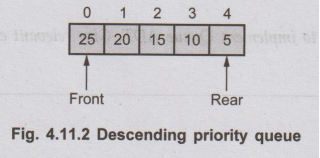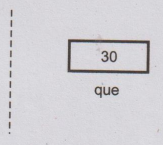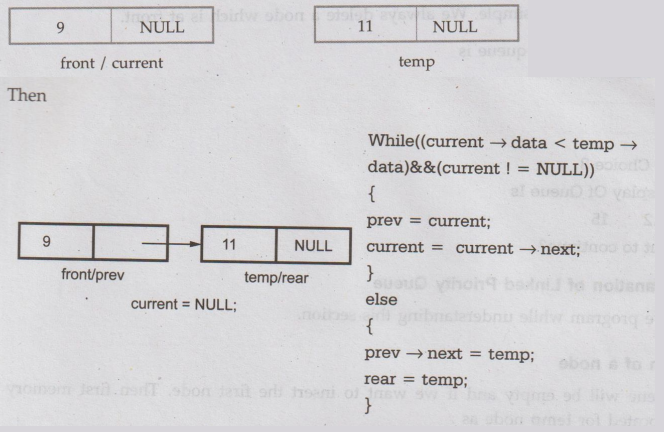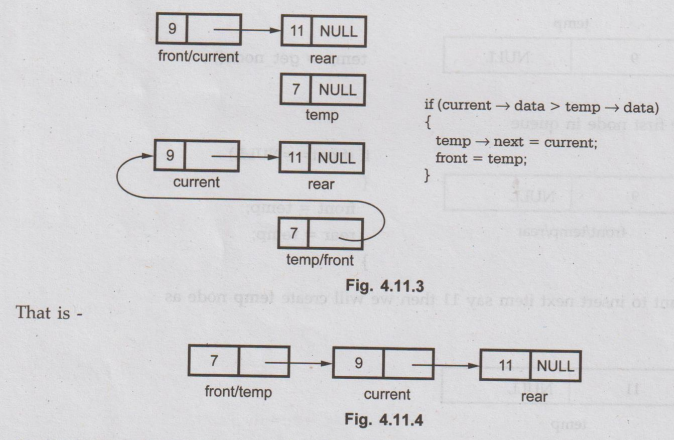C Programming and Data Structures: Unit III: b. Linear Data Structures Stacks and Queues
Priority Queues
Definition, Application, Types, Operations, Structure, Example C programs
• Definition: The priority queue is a data structure having a collection of elements which are associated with specific ordering.
Priority Queues
AU: Dec.-19, Marks 15
• Definition:
The priority queue is a data structure having a collection of elements which
are associated with specific ordering.
• There are two
types of priority queues-
1. Ascending priority queue 2. Descending
priority queue.
Application of Priority Queue
1.
The typical example of priority queue is scheduling the jobs in operating
system. Typically operating system allocates priority to jobs. The jobs are
placed in the queue and position of the job in priority queue determines their
priority. In operating system there are three kinds of jobs. These are real
time jobs, foreground jobs and background jobs. The operating system always
schedules the real time jobs first. If there is no real time job pending then
it schedules foreground jobs. Lastly if no real time or foreground jobs are
pending then operating system schedules the background jobs.
2.
In network communication, to manage limited bandwidth for transmission the
priority queue is used.
3.
In simulation modelling, to manage the discrete events the priority queue is
used.
Types of Priority Queue
The
elements in the priority queue have specific ordering. There are two types of
priority queues -
1. Ascending priority queue:
An ascending order priority queue gives the highest priority to the lower
number in that queue.

2. Descending priority queue: A
descending order priority queue gives the highest priority to the highest
number in that queue.

In
priority queue, the elements are arranged in any order and out of which only
the smallest or largest element allowed to delete each time.
The
implementation of priority queue can be done using arrays or linked list. The
data structure heap is used to implement the priority queue effectively.
ADT for Priority Queue
Various
operations that can be performed on priority queue are
1.
Insertion
2.
Deletion
3.
Display
Hence
the ADT for priority queue is given as below -
Instances:
P_que[MAX] is a finite collection of
elements associated with some priority.
Precondition :
The
front and rear should be within the maximum size MAX.
Before
insertion operation, whether the queue is full or not is checked.
Before
any deletion operation, whether the queue is empty or not is checked.
Operations :
1.
create() - The queue is created by declaring the data structure for it.
2.
insert() The element can be inserted in the queue.
3.
delet() - If the priority queue is ascending priority queue then only smallest
element is deleted each time. And if the priority queue is descending priority
queue then only largest element is deleted each time.
4.
display() The elements of queue are displayed from front to rear.
The
implementation of priority queue using arrays is as given below -
1. Insertion operation
While
implementing the priority queue we will apply a simple logic. That is while
inserting the element we will insert the element in the array at the proper
position. For example, if the elements are placed in the queue as

And
now if an element 8 is to be inserted in the queue then it will be at 0th
location as -

If
the next element comes as 11 then the queue will be -

The
C function for this operation is as given below -
int
insert(int que[SIZE],int rear,int front)
{
int
item,j;
printf("\nEnter
the element: ");
scanf("%d",
&item);
if(front
==-1)
front++;
j=rear;
while(j>=0
&& item<que[j])
{
quelj+1]=que[j];
j-
-;
}
que[j+1]=item;
rear=rear+1;
return
rear;
}
2. Deletion operation
In
the deletion operation we are simply removing the element at the front.
For
example, if queue is created like this -

Then
the element at que[0] will be deleted first.

and
then new front will be que[1].
The
deletion operation in C is as given below -
int
delet(int que[SIZE],int front)
{
int
item;
item=que[front];
printf(“\n
The item deleted is %d”,item);
front++;
return
front;
}
The
complete implementation of priority queue is as given below -
Ex. 4.11.1: Implementation of Priority Queue
Sol. :
/******************************************************************Program
for implementing the ascending priority Queue
**************************************************************/
/*Header
Files*/
#include<stdio.h>
#include<conio.h>
#define
SIZE 5
void
main(void)
{
int
rear,front,que[SIZE], choice;
int
Qfull(int rear), Qempty(int rear,int front);
int insert(int que[SIZE], int rear,int front);
int delet(int que [SIZE], int front);
void
display(int que[SIZE], int rear,int front);
char
ans;
clrscr();
front=0;
rear=-1;
do
{
clrscr();
printf("\n\t\t
Priority Queue\n");
printf("\n
Main Menu");
printf("\n1.Insert\n2.Delete\n3.Display");
printf("\n
Enter Your Choice: ");
scanf("%d",
&choice);
switch(choice)
{
case
1:if(Qfull(rear))
printf("\n
Queue IS full");
else
rear=insert(que,rear,
front);
break;
case
2:if(Qempty(rear, front))
printf("\n
Cannot delete element");
else
front=delet(que,
front);
break;
case
3:if(Qempty(rear, front))
printf("\n
Queue is empty");
else
display(que,rear,
front);
break;
default:printf("\n
Wrong choice");
break;
}
printf("\n
Do You Want To continue?");
ans
=getche();
}
while(ans == 'Y' || ans =='y');
getch();
}
int
insert(int que [SIZE], int rear,int front)
{
int
item,j;
printf("\nEnter
the element: ");
scanf("%d",
&item);
if(front
= = -1)
front++;
j=rear;
while(j>=0
&& item<que[j])
{
que[j+1]=que[j];
j-
-;
}
que[j+1]=item;
rear=rear+1;
return
rear;
}
int
Qfull(int rear)
{
if(rear==SIZE-1)
return
1;
else
return
0;
}
int
delet(int que[SIZE], int front)
{
int
item;
item=que[front];
printf("\n
The item deleted is %d",item);
front++;
return
front;
}
Qempty(int
rear,int front)
{
if((front==-1)
| | (front>rear))
return
1;
else
return
0;
}
void
display(int que[SIZE], int rear,int front)
{
int
i;
printf("\n
The queue is:");
for(i=front;i<=rear;i++)
printf("%d",que[i]);
}
Output
Priority
Queue
Main
Menu
1.Insert
2.Delete
3.Display
Output
Enter Your Choice: 1

Enter
the element: 30
Do
You Want TO continue?
Priority
Queue
Main
Menu
1.Insert
2.Delete
3.Display
Enter
Your Choice: 1

Enter
the element: 10
Do
You Want TO continue?
Priority
Queue
Main
Menu
1.Insert
2.Delete
3.Display
Enter
Your Choice: 1

Enter
the element: 20
Do
You Want TO continue?
Priority
Queue
Main
Menu
1.Insert
2.Delete
3.Display
Enter
Your Choice: 1

Enter
the element: 50
Do
You Want TO continue?
Priority
Queue
Main
Menu
1.Insert
2.Delete
3.Display
Enter
Your Choice: 1

Enter
the element: 40
Do
You Want TO continue?
Priority
Queue
Main
Menu
1.Insert
2.Delete
3.Display
Enter
Your Choice: 3

The
queue is: 10 20 30 40 50
Do
You Want TO continue?
Priority
Queue
Main
Menu
1.Insert
2.Delete
3.Display
Enter
Your Choice: 2

The
item deleted is 10
Do
You Want TO continue?
Priority
Queue
Main
Menu
1.Insert
2.Delete
3.Display
Enter
Your Choice: 2

The
item deleted is 20
Do
You Want TO continue?
Priority
Queue
Main
Menu
1.Insert
2.Delete
3.Display
Enter
Your Choice: 2

The
item deleted is 30
Do
You Want TO continue?
Priority
Queue
Main
Menu
1.Insert
2.Delete
3.Display
Enter
Your Choice: 2

The
item deleted is 40
Do
You Want TO continue?
Priority
Queue
Main
Menu
1.Insert
2.Delete
3.Display
Enter
Your Choice: 2
The
item deleted is 50
Do
You Want TO continue?
Priority
Queue
Main
Menu
1.Insert
2.Delete
3.Display
Enter
Your Choice: 2
Cannot
delete element
Do
You Want TO continue?
Priority
Queue
Main
Menu
1.Insert
2.Delete
3.Display
Enter
Your Choice: 3
Queue
is empty
Do
You Want TO continue?n
Ex. 4.11.2:
Write
program for implementing the linked priority queue.
Sol. :
#include<stdio.h>
#include<stdlib.h>
#include<conio.h>
/*Declaration
of Linked Queue data structure*/
typedef
struct node
{
int
data;
struct
node *next;
}Q;
Q
*front, *rear;
/*
The
main Function
*/
void
main(void)
{
char
ans;
int
choice;
void
insert();
Q
*delet();
void
display(Q *);
front=
NULL;
rear=
NULL;
do
{
printf("\n\tProgram
For Linked priority Queue\n");
printf("\n
Main Menu");
printf("\n1.Insert\n2.Delete
\n3.Display");
printf("\n
Enter Your Choice");
scanf("%d",
&choice);
switch(choice)
{
case
1 : insert();
break;
case
2:front = delet();
break;
case
3 :display(front);
break;
default:printf("\nYou
have entered Wrong Choice\n");
break;
}
printf("\nDo
you want to continue?\n");
flushall();
ans
= getch();
}
while(ans=='y' || ans == 'Y');
getch();
clrscr();
}
/*
The
get_node function
*/
Q
*get_node(Q *temp)
{
temp
=(Q*)malloc(sizeof(Q));
temp->next
= NULL;
return
temp;
}
/*
The
insert Function
*/
void
insert()
{
char
ch;
Q
*temp, *current, *prev; clrscr();
temp
=get_node(temp); /* allocates memory for temp node*/
printf("\n\n\n\tInsert
the element in the Queue\n");
scanf("%d",&temp->data);
/*The
new node which is to be inserted is temp */
if(front
== NULL)/* creating first node*/
{
front=
temp;
rear=temp;
}
else/*first
node is created and next node is to be attached*/
{
current=front;
/*current
node is to be compared with every node from beginnning*/
prev=current;
/*if
temp node is attached as a first node to remaining list*/
if(current->data>temp->data)
{
temp->next=current;
front=temp;/*update
front*/
}
/*if
temp node is to be inserted in between*/
else
{
while((current->data
<temp->data)&&(current!= NULL))
{
/*prev
is previous to current node */
prev=current;
current=current->next;
}/*end
of while*/
/*if
temp->data>current->data and current node!= NULL*/
if(current)
{
prev->next=temp;
temp->next
= current;
}
/*attaching
temp as a last node when temp has greaest among all the nodes in the list and
we have reached at the end of the list*/
else
{
prev->next=temp;
rear=temp;/*as
temp is appended, rear is changed,temp becomes rear*/
}
}
}/*closing
the outermost else*/
}
/*
The
delet Function
*/
Q
*delet()
{
Q
*temp;
int
Qempty(Q *front);
temp=front;
if(Qempty(front))
{
printf("\n\n\t\tSorry!The
Queue Is Empty\n");
printf("\n
Can not delete the element");
}
else
{
printf("\n\tThe
deleted Element Is %d ",temp->data);
front=front->next;/*deleting
the front node*/
temp->next
= NULL;
free(temp);
}
return
front;
}
/*
The
QEmpty Function
*/
int
Qempty(Q *front)
{
if(front==
NULL)
return
1;
else
return
0;
}
/*
The
display Function
Input:
front pointer
Called
By:main
Calls:QEmpty
*/
void
display(Q *front)
{
if(Qempty(front))
printf("\n
The Queue Is Empty\n");
else
{
printf("\n\t
The Display Of Queue Is \n");
/*queue
is displayed from front to rear*/
for(;front!=rear->next;front=front->next)
printf("\t%d
",front->data);
}
getch();
}
Output
Program
For Linked Priority Queue
Main
Menu
1.Insert
2.Delete
3.Display
Enter
Your Choice 1
Insert
the element in the Queue
9
Do
you want to continue?
Program
For Linked Priority Queue
Main
Menu
1.Insert
2.Delete
3.Display
Enter
Your Choice 1
Insert
the element in the Queue
11
Do
you want to continue?
Program
For Linked Priority Queue
Main
Menu
1.Insert
2.Delete
3.Display
Enter
Your Choice 1
Insert
the element in the Queue
15
Do
you want to continue?
Program
For Linked Priority Queue
Main
Menu
1.Insert
2.Delete
3.Display
Enter
Your Choice 1
Insert
the element in the Queue
7
Do
you want to continue?
Program
For Linked Priority Queue
Main
Menu
1.Insert
2.Delete
3.Display
Enter
Your Choice 1
Insert
the element in the Queue
12
Do
you want to continue?
Program
For Linked Priority Queue
Main
Menu
1.Insert
2.Delete
3.Display
Enter
Your Choice 3
The
Display Of Queue Is
7
9 11 12 15
Do
you want to continue?
Program
For Linked Priority Queue
Main
Menu
1.Insert
2.Delete
3.Display
Enter
Your Choice 2
The
deleted Element Is 7
Do
you want to continue?
Program
For Linked Priority Queue
Main
Menu
1.Insert
2.Delete
3.Display
Enter
Your Choice 2
The
deleted Element Is 9
Do
you want to continue?
Program
For Linked Priority Queue
Main
Menu
1.Insert
2.Delete
3.Display
Enter
Your Choice
The
Display Of Queue Is
11
12 15
Do
you want to continue?
Logic Explanation of Linked
Priority Queue
Refer
above program while understanding this section.
1. Insertion of a node
Initially
queue will be empty and if we want to insert the first node. Then first memory
will get allocated for temp node as
:
If
we want to insert 9 then

temp
= get_node();
As
it is our first node in queue

if
(front== NULL)
{
front
= temp;
rear
= temp;
}
Now, if want to insert next item say 11 then
we will create temp node as

Then
we will start scanning the queue from beginning because we want to insert node
with '11' at proper place.

While((current
→ data < temp → data)&&(current != NULL))
{
prev
= current;
current
= current →next;
current
= NULL;
}
else
{
prev
→next
= temp;
rear
= temp;
}
Now
if we want to insert temp node with
value '7' in the linked queue then we will find the position for temp node in linked queue.

if
(current → data > temp → data)
{
temp
→
next = current;
front = temp;
}
Continuing
in this fashion we create a linked list in an ascending order.
2. Deletion of a node
The
deletion operation is simple. We always delete a node which is at front.
Consider
that the priority queue is

temp=front;
printf("\n\t
The deleted element is%d", temp → data);
front
=front →
next;
temp
→
next =NULL;
Review Question
1. Implement a
priority queue using linked list. AU: Dec.-19, Marks 15
C Programming and Data Structures: Unit III: b. Linear Data Structures Stacks and Queues : Tag: : Definition, Application, Types, Operations, Structure, Example C programs - Priority Queues
Related Topics
Related Subjects
C Programming and Data Structures
CS3353 3rd Semester EEE, ECE Dept | 2021 Regulation | 3rd Semester EEE Dept 2021 Regulation
